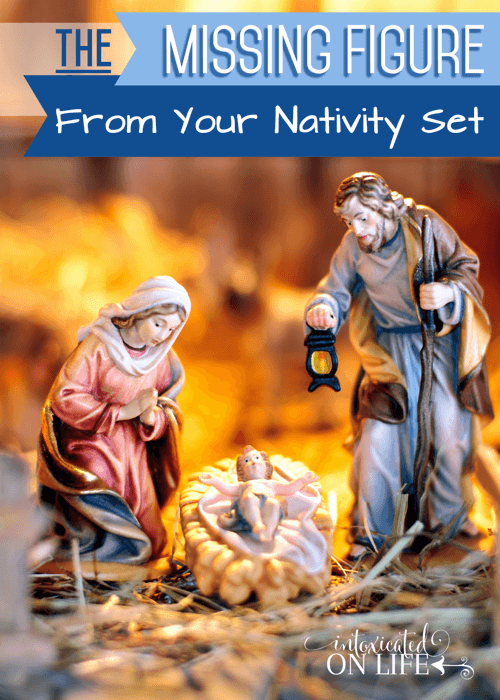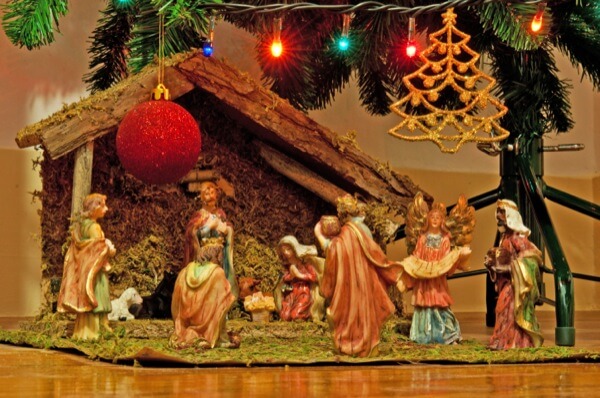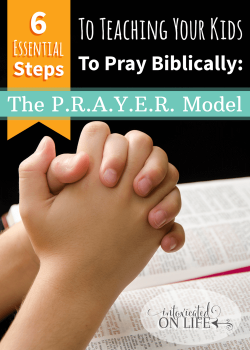Nativity sets come in all shapes and sizes. Some contain only a few figures. Others look like small-scale petting zoos, minus the pleasant aroma.
Usually the characters in a Nativity set come from Luke 2 (shepherds, angels, and animals), Matthew 2 (wise men), or both (Jesus, Mary, and Joseph), and occasionally Nativity-makers get ambitious and throw in a cast of non-biblical extras: Roman soldiers, the innkeeper’s wife, a little drummer boy, or even Santa Claus (just bizarre). All of these figures are interesting characters to talk about with our kids.

But the one figure they always leave out is the seven-headed dragon.
A Manger Full of Dragon Drool
While Luke gives an historical account of Jesus’ birth, and Matthew briefly mentions it, it is John who was given a revelation of Christmas from a cosmic perspective:
“And a great sign appeared in heaven: a woman clothed with the sun, with the moon under her feet, and on her head a crown of twelve stars. She was pregnant and was crying out in birth pains and the agony of giving birth. And another sign appeared in heaven: behold, a great red dragon, with seven heads and ten horns, and on his heads seven diadems. His tail swept down a third of the stars of heaven and cast them to the earth. And the dragon stood before the woman who was about to give birth, so that when she bore her child he might devour it. She gave birth to a male child, one who is to rule all the nations with a rod of iron, but her child was caught up to God and to his throne.” (Revelation 12:1-5)
What are we to make of this mysterious text? There are many interpretations of the last book of the Bible, and the theological debates can be dizzying—as G.K. Chesterton said, “St. John saw many strange things in his Revelation, but nothing as strange as his interpreters.”
Nonetheless, the book of Revelation interprets two of the characters for us. Most commentators agree that the male child is Jesus. He is called “one who is to rule all the nations with a rod of iron” (12:5). This expression is borrowed from Psalm 2:9, a messianic prophecy. Several chapters later John identifies this person as the Word of God, the King of kings, Jesus Christ (19:15). In this text, John briefly mentions Jesus’ birth but then quickly fast-forwards through 30+ years of His life—skipping over His childhood, life in Nazareth, preaching, miracles, death, and resurrection—to the moment of His ascension.
The figure that dominates the text is the seven-headed dragon, Satan: “that ancient serpent, who is called the devil and Satan, the deceiver of the whole world” (12:9), and he is poised to strike the baby king the moment he is born. The image is deliberately grotesque as we’re meant to picture a woman in groaning in pains of childbirth and this foul creature looming over her ready to devour her baby.
This is the picture of Christmas from the perspective of the heavenly realms. On Christmas cards and in Nativity sets we see the tranquility and simplicity of Jesus’ birth. But in John’s Revelation, all is not calm and bright: the heavens themselves are shaken as Satan summons up his forces for war to destroy the royal baby.
Why Satan Matters at Christmas
While I don’t know anyone who sells ceramic seven-headed red dragons to add to our nativity sets, we should make a point to remember him at Christmas—and talk about him with our children.
1. Satan reminds us who the baby in the manger really is.
Any child will tell you: in fairy tales, dragons don’t summon heavenly armies to attack a mere peasant born in a stable. When the powers of darkness muster all their strength, it can only be that the baby being born is powerful enough to bring them all down.
This little Lord Jesus, laying down his sweet head, will one day be crowned with many crowns. This holy infant, so tender and mild, will one day have eyes that blaze with fire and will have his linen robe dipped in blood. This little babe, the son of Mary, will one day summon fire from heaven and hurl the great dragon into the lake of fire and sulfur to burn for all eternity.
Don’t let the soft skin and tender smile fool you. This holy child is dangerous.
2. Satan reminds us that Christmas was a heavenly invasion into enemy territory.
Since the Fall of mankind, Satan has been the great rebel force behind the evils of this world. Jesus calls Satan “the ruler of this world” (John 12:31; 14:30). The apostle John writes, “the whole world lies in the power of the evil one” (1 John 5:19). The apostle Paul calls Satan “the god of this age” (2 Corinthians 4:4) who blinds the world from seeing the glory of Christ. This world is under the sway of Satan’s power.
But when Christ came, He came invading Satan’s domain. During Christ’s ministry, He cast demons out of people with startling authority (Mark 1:27). Christ likened Himself to someone who had bound “the strong man” and plundered his house (Matthew 12:28-29)—each dramatic deliverance from demonic power was a sign to everyone that the kingdom of God had arrived. He commissioned the 12 disciples and then 72 others to deliver people from demonic oppression, and everywhere they went, they displayed Christ’s power (Matthew 10:8; Luke 10:17).
This was the reason Satan was poised to kill Jesus. This little boy asleep on the hay held the power to overthrow the devil’s kingdom. “The reason the Son of God appeared was to destroy the works of the devil” (1 John 3:8).
3. Satan reminds us that all the attacks on Christ’s life were coordinated strikes.
The song, “What Child is This?” calls earthly kings to enthrone Christ in their hearts. But when King Herod the Great heard of the birth of the Messiah, he stopped at nothing to kill Him, even if it meant slaughtering countless children (Matthew 2:16).
People in His own hometown tried to throw Him off a cliff (Luke 4:29). On two occasions He was threatened by crowds who intended to stone Him to death (John 8:59; 10:31). On multiple occasions Jewish leaders secretly met, devising plots to kill Jesus (Mark 3:6; John 5:16; 7:30-32, 40-44; 11:47). His own people verbally derided Him as a poor, uneducated bastard son from the wrong neighborhood (Mark 6:3; John 7:14-15, 52; 8:19). Worse yet, he was called a false prophet, a liar, insane, demon possessed, and a blasphemer (Mark 3:22; John 7:10-13, 50-52; 10:20, 31-33).
Revelation reminds us that behind all these attacks was the god of this age, Satan himself. Satan entered Judas to entice him to hand Jesus over to the authorities (Luke 22:3; John 13:27), but in reality Satan is the spirit at work in all the sons of disobedience (Ephesians 2:2). Satan was out to bring Christ down.
3. Satan reminds us that Christ came to pardons our sins.
After Christ ascended to heaven, Revelation tells us that a great war arose between the armies of the archangel Michael and the armies of Satan. At the climax of the war, Michael ejects Satan from the heavenly realms (Revelation 12:7-12).
The critical question is: Why does Christ’s life on earth bring about Satan’s downfall in heaven?
The meaning of Satan’s name is “accuser.” Revelation 12 states he is “accuser of our brothers” (12:10), standing before God day and night recounting our sins. In the Old Testament (Job 1 and Zechariah 3), we find Satan standing before God as a prosecuting attorney: he slanders us before God, appealing to God’s law and condemning us as guilty.
But Paul says that through the cross, Christ “disarmed the rulers and authorities,” and he did this “by canceling the record of debt that stood against us with its legal demands” (Colossians 2:14-15). Satan’s only ammunition against us before God was our guilt, but now that guilt is gone. We have a perfect defense attorney: “if anyone does sin, we have an advocate with the Father, Jesus Christ the righteous. He is the propitiation for our sins, and not for ours only but also for the sins of the whole world” (1 John 2:1-2).
Glory to God in the Lowest
We often echo the words of the angels over the fields of Bethlehem at Christmas: Gloria in excelsis Deo, “Glory to God in the highest.” We hope to catch a bit of their joy in our songs and carols.
But when we read about Christmas from Satan’s point of view, we see the flip side of the coin: the utter terror the baby Jesus struck in the heart of the devil’s heart.
Reflecting on Revelation’s vision of Christmas, Philip Yancey writes,
“As a Christian I believe that we live in parallel worlds. One world consists of hills and lakes and barns and politicians and shepherds watching their flocks by night. The other consists of angels and sinister forces and somewhere out there places called heaven and hell. One night in the cold, in the dark, among the wrinkled hills of Bethlehem, those two worlds came together at a dramatic point of intersection. God, who knows no before or after, entered time and space. God, who knows no boundaries took on the shocking confines of a baby’s skin, the ominous constrains of mortality…Little wonder a choir or angels broke out in spontaneous song, disturbing not only a few shepherds but the entire universe.” (The Jesus I Never Knew, p.44-45)
Why Satan Matters at Christmas
Learn more about this text in Revelation 12. This is a sermon I preached at my church to explain it.











I never put those two stories together in my mind. Wow, thanks for giving my mind something to think about this month. I think that Christmas signals that Jesus was born and that it is such a great thing, which it is. However, the idea of what this truly means is quite extreme. I just might have to get a dragon for my nativity. This is not all happiness and giggles. It is a BIG deal. Many have died. More will.
I’m on the hunt for a seven-headed dragon, so if you find one, let me know. 🙂
I’d look for a hydra. It might be easier to have a name to go with a dragon that has many heads. I love this article by the way. It comes from a perspective that I just never even think of. Once reading it though, it makes complete sense. I love it when someone says something that makes you really think about what you believe in a different light.
Thanks, Amanda. Yes, a hydra might work well. 🙂
amazon carries a 7 -headed red dragon about 14″ tall. I found mine on ebay. I have an awesome nativity picture with the dragon, but I don’t know how to post the pic.
can you message it to me on Facebook? I’d love to see it – I’ve been searching! Cynthia Reynolds Higginson
Here’s the link to the 7-headed red dragon on amazon.
Perfect!
This is certainly something to think about and something I can’t say I have ever considered in relation to Christmas. I think at the very least it is a great reminder that the birth of the son of God into the very world He created was no small thing.
I do have one thing I would point out, which I don’t think is splitting hairs, though it may seem like it. Saying that Christ came to pardon our sins makes it sound like the sins were forgiven without a penalty paid. As in a criminal is pardoned and he is off the hook even though no justice was served. Correct me if I’m wrong, but I think it is more accurately put that Christ took our punishment, that He bore the full weight of the wrath of God that our sins deserved. Justice was found at the cross.
Again, I know that this was not the central thrust to your article, but it stuck out to me and I thought I would take a minute to offer dialogue about the difference.
Hi Lisa, thanks for the comment. I completely agree that Christ took our punishment—no disagreement there. As for the word “pardon,” I can see why that would be a problem since one of its definitions is the excusing of an offense without exacting a penalty. I think one of the reasons why English Bible translators still use the word “pardon” throughout the Bible is because it can also mean a release from the legal penalties of an offense—in other words, it describes the lifting of the penalty from the guilty party (without necessarily indicating how that penalty was lifted).
It’s not splitting hairs because its a good question. There is just more than one way the word “pardon” can be defined, and like many words, its scope is limited. We might say the same thing about the word “forgive” which can mean to giving up resentment or a claim to revenge—the definition doesn’t include any thought as to how that wrath is absorbed.
This is why I included the verse from 1 John 2: Christ is the propitiation for our sins. You are correct, Lisa, that we need to be clear that the reason anyone can receive forgiveness at all is because Christ is the atoning sacrifice for our sins.
Great article. I have read elsewhere how King Herod is the missing figure in our nativity sets; kind of along the same lines as what you wrote here. Christmas is not only a feel good holiday; reminds us of the warfare that we are involved in on a regular basis if we are in His Kingdom.
Exactly, Jennifer.
Luke, it is true if you read in Luke chapter 2 that the only ones at the manger were Joseph, Mary, Angels and live stock, however, if you read in Mathew 2:11 the wise men were never at the manger, the first time they saw Jesus was as a young boy at his house. It is a big misconception that the Wise Men saw Jesus at the manger.
Right. This is why, in the article, I never talk about the Wise Men being at the manger in the biblical account, just that they are presented in a lot of Nativity scenes. What I wrote above was that Matthew only briefly mentions Jesus’ birth—it does not have a birth narrative.
powerful, but awesome stuff. In all my life I never put Satan there. I have read the Bible but I guess my brain didn’t put it together. thank you for this. this definitely puts a new take on things for me. a must share with my kids to show how hateful the devil really is. thanks again
Thanks, Amy!
I believe in this verse, the woman is the Church and her child is the Kingdom. But I totally believe the day of Christ’s birth was a bad one for Satan. He tried to have him destroyed on more than one occasion before all could be fulfilled. Thank goodness we worship an all powerful God who was and is and will be victorious.
Interesting interpretation. Why is this the birth of the kingdom and not the King?
I think the woman is Israel (12 stars in her crown = 12 tribes?) and Jesus is the child being born.
Yes, many think that. She seems to represent God’s people who came before Jesus. In the book of Genesis, Joseph has a prophetic dream, and in the dream he and his 11 brothers are symbolized as 12 stars, his father Jacob is the sun, and his mother is the moon—notice, the same symbols used here in Revelation. Since Joseph’s family was the patriarchal family of all the people of Israel, this symbol of the woman seems to be a symbol for the people of God before Jesus.
Interesting to read other’s thoughts on this. I need to go and research more.
Please do and let me know what you find!
I might frustrate you with my opinion, but don’t you think you that Christmas is about being thankful for what Christ went through for us?…the very fact that God could have walked away from us (vile humanity) and yet he didn’t? Instead, he sent a piece of himself, his only son to take the wrath we so deserved. I think as Christians we need to be VERY careful not to give any glory to Satan on this day…he never had any power in the first place…do we really think he could have seriously destroyed our Savior? I get what you are saying, but isn’t the focus all off? Yes, there is no debate that Satan was affected by Jesus’ birth and more and that spiritual warfare is very real, but Christians can get a bit too zealous with it (just as our society has with angels). I am not burying my head in the sand or denying that the Devil was there that day, but we don’t really have all the facts on Revelation as to what that verse really refers to. No offense, but I think my family and I will keep our homemade nativity the way it is: focusing on the miracle, the mercy, the blessing that is Christ.
I don’t disagree with the spirit of your statement, but I am trying to be faithful to Scripture here. I think if Revelation glorifies Christ by showing the demolition of Satan’s authority, so should we. If part of the glory of the incarnation and work of Christ is that he dethrones Satan as “the ruler of this world” (John 12:31; 14:30), then we should celebrate that fact. If it is fitting to teach our kids about Christmas from Mary’s perspective or Joseph’s perspective, why not from Satan’s? The point of this article is not to glorify Satan, but to show the enormity of Christ’s victory over such a great foe.
I don’t know about 7-headed (I didn’t look), but Safari, Ltd. makes dragons. I saw a bunch of them at Michael’s the other day.
I had to laugh a little…your ad is showing “Dragon NaturallySpeaking.” I guess it thinks that’s relevant to the context.
On a more serious note, though, this is a really good observation. I wonder if it would make an impact on our kids to ADD a dragon to the nativity when they’re not around and wait for them to find it and ask why.
Ooooh, great idea, Rachel! I think that would definitely make a stronger impression on them by doing it that way. It would really make them stop and think about it.
Cool idea. I think at the very least something like that could arrest their attention. While the Book of Revelation may be lost on them, surely they could wrap their minds around all the stories from the four Gospels about how Jesus was persecuted and tempted during his lifetime, then just talk about how Satan was the personal power behind all of them.
My kids span a pretty wide age range, so I think the bigger ones might understand Revelation — at least in part. The little ones wouldn’t, though — just the things you described in your comment.
Well, Safari has a FOUR-headed dragon: http://www.amazon.com/dp/B000GECCHY/
And a Hydra, which appears to have five heads: http://www.amazon.com/Safari-Ltd-Mythical-Realms-Hydra/dp/B007APP1NO/
So powerful. THANK YOU for sharing!
You’re welcome, Jessica!
I like this – neat! Amazon has a red, seven headed toy dragon. I am very inspired to get something like that, even though I’m not really all that big on dragons. I’m a big fan of tangible ways to engage our children and help them remember important concepts.
Drop a link to that item. I’d love to see it!